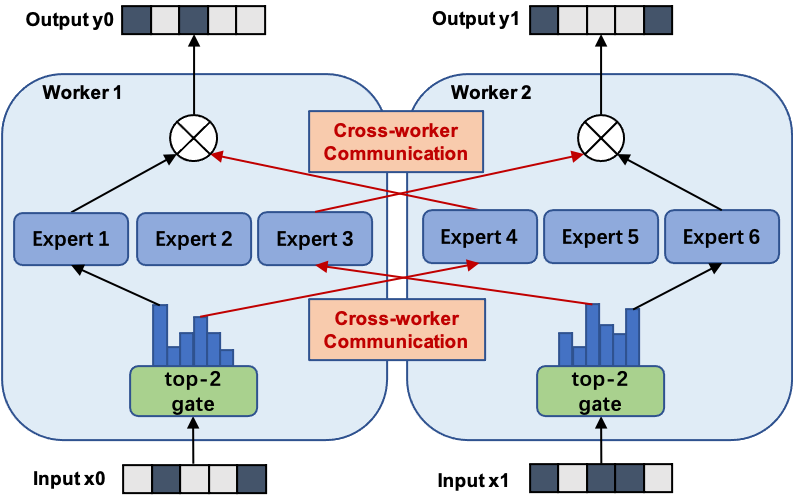Release note | 中文文档 | Slack workspace
An easy-to-use and efficient system to support the Mixture of Experts (MoE) model for PyTorch.
PyTorch with CUDA is required. The repository is currently tested with PyTorch v1.8.0 and CUDA 10, with designed compatibility to older versions.
If the distributed expert feature is enabled, NCCL with P2P communication
support, typically versions >=2.7.5, is needed.
FastMoE contains a set of PyTorch customized opearators, including both C and
Python components. Use python setup.py install to easily install and enjoy
using FastMoE for training.
The distributed expert feature is disabled by default. If you want to enable
it, pass environment variable USE_NCCL=1 to the setup script.
Note that an extra NCCL developer package is needed, which has to be consistant
with your PyTorch's NCCL version, which can be inspected by running
torch.cuda.nccl.version(). The
official PyTorch docker image is
recommended, as the environment is well-setup there. Otherwise, you can access
the download link of all NCCL
versions to download
the NCCL package that is suitable for you.
Transformer is currently one of the most popular models to be extended by MoE. Using FastMoE, a Transformer-based model can be extended as MoE by an one-key plugin shown as follow.
For example, when using Megatron-LM, using the following lines can help you easily scale up the MLP layers to multiple experts.
model = ...
from fmoe.megatron import fmoefy
model = fmoefy(model, num_experts=<number of experts per worker>)
train(model, ...)A detailed tutorial to moefy Megatron-LM can be found here.
An example MoE transformer model can be seen in the
Transformer-XL example. The easist way is to replace
the MLP layer by the FMoE layers.
FastMoE supports both data parallel and model parallel.
In FastMoE's data parallel mode, both the gate and the experts are replicated on each worker. The following figure shows the forward pass of a 3-expert MoE with 2-way data parallel.
For data parallel, no extra coding is needed. FastMoE works seamlessly with PyTorch's DataParallel or DistributedDataParallel.
The only drawback of data parallel is that the number of experts is constrained by each worker's memory.
In FastMoE's model parallel mode, the gate network is still replicated on each worker but experts are placed separately across workers. Thus, by introducing additional communication cost, FastMoE enjoys a large expert pool whose size is proportional to the number of workers.
The following figure shows the forward pass of a 6-expert MoE with 2-way model parallel. Note that experts 1-3 are located in worker 1 while experts 4-6 are located in worker 2.
FastMoE's model parallel requires sophiscated parallel strategies that neither PyTorch nor
Megatron-LM provides. The fmoe.DistributedGroupedDataParallel module is
introduced to replace PyTorch's DDP module.
@article{he2021fastmoe,
title={FastMoE: A Fast Mixture-of-Expert Training System},
author={Jiaao He and Jiezhong Qiu and Aohan Zeng and Zhilin Yang and Jidong Zhai and Jie Tang},
journal={arXiv preprint arXiv:2103.13262},
year={2021}
}
If you have any problem using FastMoE, or you are interested in getting involved in developing FastMoE, feel free to join the our slack channel.


